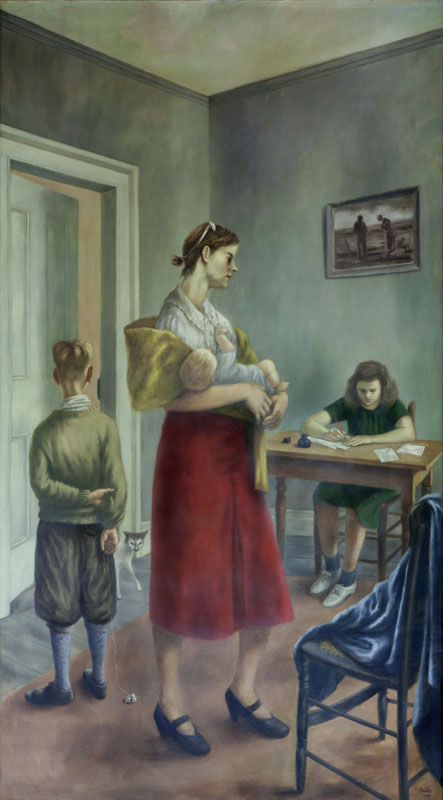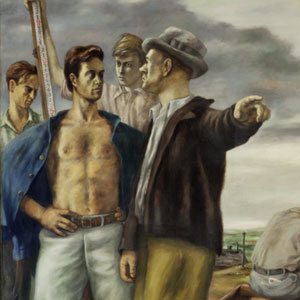Writing the Family Letter
1939
oil on canvas
134 x 75 in. (340.4 x 190.5 cm)
Commissioned through the Section of Fine Arts, 1934-1943
FA561B
Photo by Carol M. Highsmith
Reading the Family Letter
1939
oil on canvas
134 x 75 in. (340.4 x 190.5 cm)
Commissioned through the Section of Fine Arts, 1934-1943
FA561A
Photo by Carol M. Highsmith
New Deal relief efforts, aimed at creating jobs to ease the economic hardships of the Great Depression, supported both the artists and the subjects of these murals. Alexander Brook was commissioned to create these murals by the Section of Fine Arts, one of four New Deal art programs. The seated man shown in Reading the Family Letter works for the Civilian Conservation Corps (CCC), which was founded in 1933 to stem high unemployment among young, unskilled men while helping to preserve the country’s cherished natural resources. During its nine-year life, the program employed over three million workers who planted the seeds of American conservationism that continue to grow. Each man was required to send home to his family twenty-five of the thirty dollars that he earned each month from the CCC. Men were often separated from their families for long periods of time, and thus relied on the post to keep them connected, both financially and emotionally. Brook’s murals represent the post as a uniting force under the very difficult circumstances of the Great Depression.
Quiet and spare, like the easel paintings for which Brook was known, Writing the Family Letter depicts a woman and three children at home. Each figure looks away from the others, creating a sense of separation that belies their close quarters. The girl at the table writes a letter, presumably meant for the young man, shown seated in Reading the Family Letter, who has left the family to join the Civilian Conservation Corps (CCC). Men in the CCC were required to be unmarried and between the ages of eighteen and twenty-five, so the girl at the table likely writes to her brother. CCC members came from families already taking advantage of local relief efforts through the Federal Emergency Relief Administration (FERA); therefore, the patriarch of the family was probably also out working to support his wife and children. Concern for the family’s father and brother, compounded by the stresses of economic hardship, may explain the somber tone of the scene. In one of Brook’s drawings for this mural, the mother appears calm, her back to the viewer and her eyes gazing lovingly at the baby. The final composition, with the mother appearing worn and distant, conveys the sacrifices and hard work that were essential to recovering from the Great Depression. On the wall above the girl at her desk is a copy of The Angelus, a famous nineteenth-century painting by French artist Jean-François Millet, which shows a farm couple pausing from their work for evening prayers.
Alexander Brook (1898–1980)
Born in Brooklyn, New York, Alexander Brook became interested in art while recovering from polio at age twelve. In 1915 he enrolled at the Art Students League, and by the 1920s was exhibiting and working at the Whitney Studio Club, which would become the Whitney Museum of American Art in 1931. In 1929, Brook was awarded the Logan Medal by the Art Institute of Chicago, and the following year he won second prize at the Carnegie Institute International Exhibition of Modern Painting. Brook continued producing landscapes, portraits, and genre scenes in his hallmark realist style until 1966.
Alexander Brook is one of eleven artists whose murals are featured in the William Jefferson Clinton Federal Building. Brook’s murals, located in the lobby of the Benjamin Franklin U.S. Post Office, are the only pair that is completely accessible to the public. The rest of the Clinton Building is access restricted, however tours of the other Post Office Department murals are available through the U.S. General Services Administration. For more information on the GSA Fine Arts Collection in Washington, D.C., please contact artinfo@gsa.gov.

“Writing the Family Letter.” Photo by Carol M. Highsmith.

“Reading the Family Letter.” Photo by Carol M. Highsmith.

“Reading the Family Letter” and “Writing the Family Letter.” Photo by GSA.

“Writing the Family Letter.” Photo by GSA.

“Reading the Family Letter.” Photo by GSA.



 U.S. General Services Administration
U.S. General Services Administration

